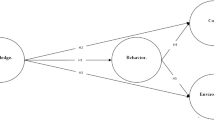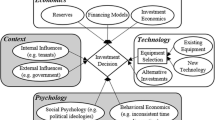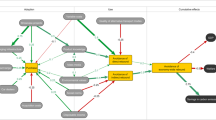Abstract
The process by which energy efficient housing alternatives is diffused through society in relation to the information flow is relatively unknown. The major purpose of this study was to validate a continuum of the propensity to adopt alternative housing (passive and active solar, earth sheltered and retrofitted) based on knowledge level. Findings indicate knowledge indices are valid predictors of consumer acceptance of energy efficient housing alternatives. A greater level of knowledge was correlated with respondents willing to adopt an alternative housing type.
Similar content being viewed by others
Bibliography
BabbieE.: 1983, The Practice of Social Research, 3rd Ed. (Belmont, CA: Wadsworth Publishing Company), pp. 367–388.
BohlenJ. M.: 1968, ‘Research needed on adoption models’, in Difusion Research Needs, NC Regional Research Bulletin 186, (Missouri Agricultural Experiment Station, Columbia, MO), pp. 15–21.
CombsE. R. and MaddenC. S.: 1983, ‘Compatibility of solar home heating systems with values, felt needs, and past experiences of households’. Home Economics Research Journal II, 3, pp. 304–316.
Combs, E. R. and Parkhurst, A. M.: 1983, ‘Solar heating Systems: differentiation between stages in the innovation-diffusion process’, in Refereed Conference, American Association of Housing Educators, Lincoln, NE.
DarleyJ. M., and BenigerJ. R.: 1981, ‘Diffusion of energy-conserving innovations’, Journal of Social Issues 37, pp. 150–171.
GoodC. V. and ScatesD. E.: 1954, Methods of Research: Educational, Psychological, Sociological, (New York: Appleton-Century Crafts), pp. 541–547.
KerlingerF. N.: 1973, Foundation of Behavioral Research Holt, Rinehart and Winston, Inc., New York.
KlonglanG. E. and CowardE. W.: 1970, ‘The concepts of symbolic interaction: a suggested interpretation’. Rural Sociology 35, 1, pp. 77–83.
LaBayD. C. and KinnearT. C.: 1981, ‘Exploring the consumer decision process in the adoption of solar energy systems’ Journal of Consumer Research 8, pp. 271–278.
LoinbergerH. F.: 1968, ‘Individual adoption behavior: applications from diffusion research — Part I’, Journal of Cooperative Extension 19, pp. 157–166.
McCray, J. W., Baird, N., Weber, M. J. and Day, S.: 1984, ‘The impact of codes and regulatory practices on the presence of energy-efficient alternative housing’, Southern Cooperative Series Bulletin S-305.
McCray, J. W. and Weber, M. J.: 1981, ‘Factors affecting the diffusion of two energy efficient innovative housing systems’, Housing and Society: Journal of the American Association of Housing Education (Special Energy Issue) 8.
Ogus, M. R.: 1982, ‘Residential energy conservation and price response’, Economic Development Division, United States Department of Agriculture.
Rogers, E. M.: 1963, ‘The adoption process’, (Parts I and II). Journal of Cooperative Extension 1.
RogersE. M.: 1968, ‘A communication research approach to the diffusion of innovations’, in ‘Diffusion Research Needs’, NC Regional Research Bulletin 186, (Missouri Agricultural Experiment Station, Columbia, MO), pp. 27–30.
RogersE. M. and ShoemakerF. F.: 1971, Communication of Innovations, 2nd Ed. (The Free Press, New York).
Rogers, E. M.: 1972, Diffusion of Innovations. (Michigan State University Press).
RyanB.: 1969, Social and Cultural Change, (The Ronald Press Company, New York), pp. 213–241.
S-141 Technical Committee' 1984, ‘Perceptions of housing alternatives’, Regional Data Book, Southern Cooperative Series Bulletin No. 298 (University of Georgia, Athens, Georgia).
ShamaA.: 1982, ‘Speeding the diffusion of solar energy innovations’, Energy 7 (8), pp. 705–715.
ShamaA. and JacobsK.: 1980, ‘Accelerating the adoption of conservation energy’, Journal of Environmental Systems 10, 4, pp. 353–365.
Solo, R. A. and Rogers, E. M.: 1972, Inducing Technological Change for Economic Growth and Development. (Michigan State University Press).
Thompson, G. P.: 1980, Housing and Energy in the Eighties: Public Regulation and Incentives (Brookings Institute).
Unseld, C. T., and Crews, P. J., ‘Innovators and their experiences’, in A. Shama (Ed.), Marketing Solar Energy Innovations. (New York: Praeger).
Author information
Authors and Affiliations
Rights and permissions
About this article
Cite this article
Weber, M.J., McCray, J.W. & Claypool, P.L. Propensity to adopt innovative housing: Development of knowledge indexes. Soc Indic Res 17, 401–421 (1985). https://doi.org/10.1007/BF00290322
Received:
Issue Date:
DOI: https://doi.org/10.1007/BF00290322




